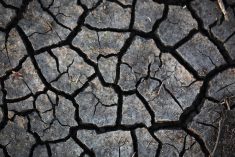Repercussions of Crow demise
Have you got a spare $22,500 in your pocket?
If so, you can pick up a snappy new report full of computerized maps that attempts to forecast how recent policy changes will affect agricultural production in Western Canada.
The report is from the WEFA Group, a U.S.-based economic information and consulting firm with a strong interest in agriculture.
Factors studied
Hugues Rinfret, head of WEFA’s Canadian agriculture analysis group, says the study looks at the end of the Crow Benefit, the change in pooling point for east-west grain transportation, international trade agreements and the changing global marketplace.
Read Also

Phosphate prices to remain high
Phosphate prices are expected to remain elevated, according to Mosaic’s president.
The information was co-ordinated to determine impact on the five major grains and oilseeds, five special crops, as well as cattle and hogs.
For easier comprehension, the stack of information went into a computerized geographic information system which builds layers of information related to physical locations.
According to WEFA, this information will be valuable to grain companies, governments and others interested in western agriculture as they plan their systems for the next century.
Given that The Western Producer didn’t have $22,500 available for research for this column, we had to settle for what WEFA would tell us for free. And the adage “you get what you pay for” seems to apply because a lot of the forecasts sound pretty familiar.
WEFA found that because of high transportation costs, feed grains grown in Manitoba and eastern Saskatchewan will have to be upgraded in value by feeding them to livestock.
Hogs will be particularly attractive in Manitoba, because of the transportation change, its proximity to population centres in the U.S. Midwest and because WEFA believes good things will flow from the end of the province’s hog marketing board monopoly.
WEFA believes Manitoba’s share of Canadian livestock production will grow by two to three percent.
Also, because it will be comparatively cheaper to transport grain and oilseeds from Alberta, acreages of wheat and canola there will increase, WEFA says. It sees Alberta’s share of western wheat acreage increasing by 1.5 percent to 25.5. Manitoba’s share is forecast to drop to 11.5 percent from 14 percent in the next five years.
WEFA believes Saskatchewan’s total share of grains and livestock won’t change much, but within the province there will be a shift of wheat and oilseeds west and livestock east. The firm also believes Saskatchewan’s pulse and special crop acreage will increase.
We’ve certainly heard the broad outline of this sort of forecast before. Maybe those who pay the full $22,500 for WEFA’s package get a lot more detail. They probably will. But even those of us who get the free summary should take note.
Impact of the Crow
The increase in grain prices over the last two years partly masked the true impact of the end of the Crow Benefit and other transportation changes.
Big companies such as Saskatchewan Wheat Pool and Schneider are already making investment decisions regarding hogs based on these sorts of forecasts.
The question is, will the right systems be in place to help farmers benefit from the changes?














